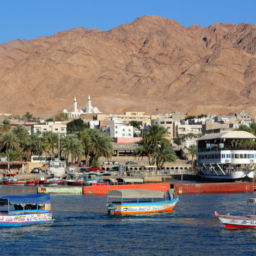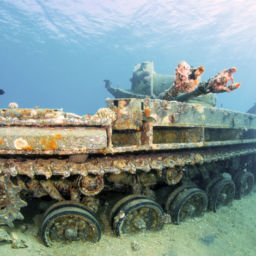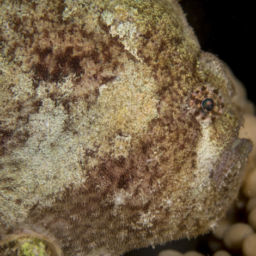Abdullah Momany is the kind of guy you want to dive with. His father Mohammed began the Red Sea Dive Center in 1990 — the first in Aqaba, Jordan — and Abdullah took over management in 2012. I’ve been at a travel conference here in Aqaba and decided to add on a few days’ of diving when the conference closed. With his encyclopedic knowledge of the dive sites and marine life in the bay, Abdullah and Red Sea Dive Center were a natural choice.
Shaped like the right side of a long-sleeved shirt, with the sleeve’s cuff bordering Syria, Jordan is entirely landlocked – except for Aqaba’s 16 miles (26 km) along the very southwestern tip. It’s for these 16 miles I’ve come: the diving in the long, thin cigar-shaped Gulf of Aqaba is, by all accounts, lovely with healthy hard coral, lots of reef fish, and easy, current-free conditions.
Diving Aqaba with Red Sea Dive Center
When the conference wraps, I head south to the dive center, which sits on a bluff overlooking the sea about 25 minutes outside of Aqaba itself. Across the bay I can see both Israel and Egypt, and about four miles south of the resort is the border with Saudi Arabia. There are 13 comfortable rooms surrounding a pool with a deep end designed for training. I make note of the chaises: those look like a perfect spot for an aprés-dive nap.
The rooms are nothing fancy, but each has a private bathroom and air-conditioning, which I barely need – surprisingly (at least to me) it’s quite temperate while I’m there. The water temperature hovers in the mid-70s (24 C) and, being the wimp that I am, I must borrow a thicker wetsuit from the dive shop than the 3 mm that I’ve brought. The real selling point of RSDC is the staff and Abdullah himself, who couldn’t be friendlier, more knowledgeable, or more excited about diving.
“My place is simple,” says Abdullah. “It’s not a luxury place, but you get what you need. You get a dive center with reliable equipment; you get good food and a comfortable bed. We are a 5-star PADI resort as well.”
Dives at RSDC begin the same: the group convenes at around 9:45 am on the shaded patio — there’s no need for crazy-early starts because there’s no current in the bay, and little tidal change. Unlike in many locations, you needn’t rise with the dawn or time your dive to any particular event, so we roll out around 10:30 – very civilized. Dive groups average four or five divers per guide, but this depends on how many divers there are and their skill level. None of the 14 sites that RSDC regularly visits are particularly challenging or deep, so it’s easy to find a group with similar abilities and join in. Most of Aqaba’s dive sites are accessible via shore or boat. Though RSDC has a boat, they conduct nearly all dives via shore since it’s so close by.
Our dive on my first day with RSDC is the wreck of the Cedar Pride, one of Aqaba’s most beloved sites.
I dove the site earlier in the week via boat — there’s a mooring buoy attached to the stern — but had trouble with my ears. Today I’m looking forward to exploring it more thoroughly. After gathering our gear, we ride in a few vans down to the beach for a shore entry. The water here is very, very salty and I’m wearing a thick wetsuit, so I’m carrying more weight than usual. The walk to the water is by far the hardest part of the dive, however, as we submerge in crystal-clear water and begin seeing coral heads in only six feet (3 m).
We begin the swim out to the wreck, which lies about 650 feet (200 m) offshore, finning slowly past busy reef fish and adorably angry clownfish, always watching for anyone who strays too close to their anemone. The wreck comes into view as we approach the bow, with the deepest point in about 85 feet (26 m) of water.
In its former life, the Cedar Pride was a Lebanese freighter. After catching fire at anchor Aqaba in 1982, the burned-out ship remained afloat for three years, with the hull intact, before it was purpose-sunk in 1985 at the behest of King Abdullah, himself a diver. In the 30-plus ensuing years it’s grown a remarkable amount of life. It lies on its starboard side, with the crow’s nest jutting out before us at an angle, covered in soft coral, fans and a hiding frogfish, I’m told later. I have no trouble with my ears on this day, and after an entirely enjoyable 45 minutes circling and peeping into the wreck, it’s time to head back to shore.
King Abdullah Reef
After two days of diving with Amer, who learned to dive at RSDC in 2002 and stuck around to become first a guide and then an instructor, it’s my last day underwater. This time I’m diving with Abdullah and the two of us are exploring King Abdullah Reef, which he was anxious to show me.
We’ve been underwater about 40 minutes when he gestures excitedly at a hawksbill turtle, the first I’ve seen on the trip. We quickly notice that not one — but two — turtles are happily resting in the sand between coral bommies. We’re the only two divers on the site, and the turtles are entirely nonplussed by our presence, lazily swimming alongside us. I swim so near one I could touch it – I don’t, of course – while Abdullah snaps away with his camera.
The reef resembles the others in the bay. It’s all one reef in Aqaba, really. A long, gradual slope recedes gently from the shoreline, and features lots of healthy, multi-colored hard coral teeming with anthias, eels, territorial clownfish, butterflyfish — the usual suspects. Here at King Abdullah Reef there are large boulders of coral as well, and overhangs hide stonefish, eels and lionfish. And today, turtles. These two stick around for quite some time while we watch them go about their day. Finally, the friendlier of the two seems to tire of our presence and turns away, heading for deeper water. Never going deeper than 60 feet (18 m), we’ve got air for days. I finally get chilly after around 62 minutes though, so we slowly return to shore.
No place like home
On our last night in town, Abdullah graciously takes me and two other RSDC guests into Aqaba — about 25 minutes to downtown — for dinner at his favorite restaurant. He’d given us the option of somewhere fancier or somewhere locals love to eat and we happily chose the latter. He orders for the table and the food just keeps coming. There’s chicken shawarma for my meat-eating friends, hummus, warm pita bread, a tomato/parsley chutney, the best falafel of the trip, and amazing homemade French fries (two orders of those). “This place is not fancy,” he says, “but I’ve been eating here my whole life and it’s the best in town.”
Over sweet tea after dinner, he talks a little bit about Aqaba and the future of the dive center. It’s grown so much in the last few years, he tells us. Bigger resorts have come in; tourism is increasing. There are challenges with growth, he says, as industry vies with tourism, and resorts, in turn, vie with each other for access to and control of the area’s waterfront. But for now, RSCD will keep on doing what it’s been doing so well for so many years.
“If you want a personal touch, you choose Red Sea Dive Center,” Abdullah says. “I do my best to create a family atmosphere. When you’re here, you’re like family. Sometimes we cook together in the kitchen. These things matter to people, these things make you feel special.”
After five days at the resort, I can’t disagree. Although it was my first visit to Jordan, I doubt it will be my last. And when I return, Red Sea Dive Center will be my first stop. As Abdullah says, “I’ve traveled all over the world, but nothing compares to home.”












